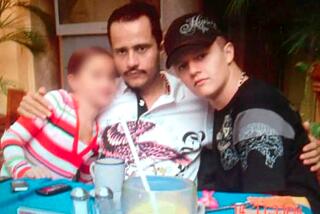Chicago’s Shorebank Earns Interest as Model for Rebirth : Renewal: It helped lift one neighborhood, and Clinton cites its success. But others point to limitations.
South Shore is not the slum it once seemed meant to be.
Two decades ago, this part of town, nine miles south of the downtown Loop, suffered from a full-blown case of white flight. In a too-familiar cycle, absentee landlords let their buildings fall--no, plunge--into disrepair; boarded-up windows, gang graffiti and litter spread from block to block.
Now South Shore’s vital signs are better, if uneven. Wrought-iron fences, new windows, hand-cleaned brick testify to a quiet, steady upswing in what has become a predominantly black, middle-class enclave.
The rescue effort was engineered by Shorebank Corp., an unusual institution centered on South Shore Bank. The bank is committed to making loans in its immediate area but generally requires property improvements as a condition of granting credit. At the same time, other Shorebank companies renovate local property with money raised outside the bank, which also fuels the rehabilitation movement.
President Clinton has cited Shorebank over and over again as the model for his proposed community development fund, which would help finance about 100 companies working to halt decline in deteriorating areas across America.
The issue is an urgent one. Recent studies have documented a lack of credit in the inner cities and markedly higher mortgage rejection rates for blacks and Latinos. Economic disparities helped fuel last spring’s unrest in Los Angeles--indeed, a team of urban experts hosted by Rebuild L.A. in the riots’ wake included a Shorebank official.
But while the tale of South Shore offers inspiration, it also sounds some cautionary notes.
What works in South Shore may not be the right medicine for rural places or other cities, or even, as the bank has found, in different sections of Chicago. Shops--and jobs--are harder to jump-start than housing upgrades, which have been the mainstay of Shorebank’s business. Crime, drugs and poor schools are problems well beyond investors’ scope.
And many South Shore residents resent what they see as outsiders who dictate what can be built where and by whom.
“This is no magic bullet,” said Shorebank President Ronald Grzywinski.
Still, fueled by Clinton’s fervor on the campaign trail, Congress conducted hearings on the concept earlier this month. Clinton wants to use federal money as an incentive to speed up this type of investment in poor neighborhoods. There are just four development banks in the United States now. Though Shorebank plans expansions and dozens of other groups are trying to organize similar operations, Clinton would like to see as many as 100 established in coming years.
The Administration is offering no details of its own plan yet. A Clinton adviser says that earlier talk of an $850-million fund, requiring $2 in private money for every $1 in federal money, may be modified.
Meanwhile, Shorebank is basking in its many Clinton ties. A new brochure boasts a cover photo of Vice President Al Gore on a visit to South Shore. The text contains references to two Shorebank officials--one a former roommate of Hillary Rodham Clinton’s--who were given roles in the transition. The First Lady was until recently also on the board of Southern Development Bank Corp., a similar operation in Arkansas run by a Shorebank alumnus.
Such heady proximity to power could never have been predicted in 1973, when Grzywinski first took over the small bank, which had granted only two mortgage loans in the previous year.
As president of Chicago-based Hyde Park Bank near the University of Chicago, Grzywinski had often talked with colleagues over after-work beers about using investment to stop a target area’s slide and also turn a profit. He was on a fellowship refining the idea when South Shore Bank became available. This, he thought, was his chance.
He bought it with $800,000 from foundations willing to take a risk but hoping for a return, and a $2.4-million loan guaranteed by himself and his wife. He brought along three friends as top managers.
Grzywinski’s neighbor, a University of Chicago social sciences professor named Richard Taub, asked if he could observe the endeavor. Granted permission, he figured he’d have a firsthand view of a business failure.
But Taub, who later wrote a book about the bank, was impressed. “A good deal of their success came from their background,” he said, noting that the top four officers, while all bankers, included a former IBM salesman (Grzywinski), a foundation executive, a civil rights activist and a one-time official of the federal Office of Economic Opportunity. Two were white and two were black.
Another crucial element was the state of South Shore itself. The area was undeniably turning seedy, but bus drivers, teachers and postal workers still lived there, all with steady incomes that could service debt. Along a few streets west of the bank, there were even stately mansions where some whites had stayed and black celebrities, including the Rev. Jesse Jackson, had homes. “South Shore,” Taub said, “was never the South Bronx.”
The Shorebank team aggressively courted depositors, placing an ad in the upscale New Yorker magazine, for example, that stressed the opportunity to do good while earning the going rate on various accounts and certificates. Nearly 60% of the bank’s deposits now come into South Shore from people as far away as Oregon and New York, according to bank President James Fletcher.
The loans, by contrast, stayed close to home--and in recent years, they have totaled more than $100 million annually.
That big increase was helped by the nearby activity of the bank’s sister companies, including the for-profit City Lands Corp. and the nonprofit Neighborhood Institute.
One example: Five of six apartment buildings overlooking a huge park were boarded up until City Lands persuaded investors to join a renovation project. The newly rehabilitated complex soon filled with tenants. Then the once-rare sight of contractors’ vans became commonplace in the adjoining streets. The neighbors were sprucing up--with loans from South Shore Bank.
Real estate agents vouch for the spillover. Alice Jennett had a difficult listing, a condominium in a well-cared-for building that happens to be next to an abandoned place with shattered glass on the lawn and nearly none in the windows. Now the Neighborhood Institute has plans to fix up the eyesore. The condo “will be much easier to sell,” Jennett said.
The bank is making a 1% return on its assets, a respectable though not remarkable profit. The mainstay of its business has turned out to be what its officers call “Ma and Pa rehabbers”--a married couple sinking a lifetime of savings from teaching and bus driving into a six-unit building, or a janitor who has set aside money while watching how his employer operates apartments.
Most of them could not have qualified for loans at any other bank. “This is old-fashioned character lending,” Grzywinski said. Owners are required to make improvements as a condition of their loan and, in some cases, must live in the building.
To advocates of a development bank system, this painstaking approach is the major argument against working through existing institutions. “In today’s world, big banks are consolidating and merging,” said Robert M. McGill, a former Federal Reserve official who is starting a development bank in Southeast San Diego. “They want to do things in a standardized way. But if you try to standardize this business, you’ll fail.”
And sometimes, even if you don’t. “I know a lot of people who got loans from South Shore Bank and they lost everything,” said local entrepreneur Moses Harris. “People moved in who could ill afford it. People bought places without the technical assistance they needed. On paper, it looks real smooth around here, but when you come down to it, people got hurt.”
Acknowledged Fletcher: “We made some mistakes. But that happens in banking.”
South Shore’s most notable lack of success was its attempt to revitalize the local commercial strips. “We have finally realized,” Fletcher said, “that nobody walks anymore. We are trying to think of what we can put there instead of stores, maybe some cultural things.”
In the meantime, though property values have risen, the run-down shops contribute to “an underlying softness in the market,” Taub said.
There are other reasons, including the troubled Chicago public schools, and crime fed by gangs and drugs.
One unqualified attraction is a three-year-old shopping center, anchored by a major-chain supermarket. Shorebank owns 45% of the property through the City Lands subsidiary. Customers clutching grocery bags talk about how glad they are that they no longer need to travel to the suburbs to stock up on food.
But the shopping plaza also left some bitterness behind. A local minister said he had plans for an old high school, once run by Dominican nuns who promised he could use the structure for day care and job training programs. But the site was condemned for employee parking for the new stores.
Shorebank officials say they wanted to avoid taking the school; they just couldn’t. The minister, the Rev. Gilbert Leigh, sees it differently. “They are enriching themselves, not the community.”
And so “the bank,” as the neighbors call it, has been the subject of many an argument at South Shore gatherings. Someone will vent suspicion about the latest project. “But without them,” more than one resident has countered, “we’d look like Woodlawn.”
Woodlawn lies just across Stony Island Avenue, South Shore’s western edge. The landscape abruptly changes there. Rows of empty buildings line the streets; more than a few are charred. Many lots are vacant altogether, except for trash and tall stands of drying weeds.
With Shorebank as the leading example, the ranks of the development banks seem destined to grow whether the federal government becomes an investor or not. Groups in San Diego, Grand Rapids, Mich., Milwaukee and elsewhere are already planning their own banking-and-stimulus ventures. They have sought financing from private foundations, corporations and even from mainstream banks. Seed money for San Diego’s Neighborhood Bancorp., for example, comes from Wells Fargo, First Interstate, Manufacturers, Union and Scripps banks.
Shorebank itself has opened a branch office in Austin, on Chicago’s west side. In the last six months, it also joined forces with a development bank organized in Michigan’s Upper Peninsula. Grzywinski and three colleagues recently drove through Cleveland’s east side, seeking the right neighborhood for a possible offshoot there. If a minority-owned Kansas City bank that Shorebank is assisting can reach financial stability, the company may expand there as well.
In Los Angeles, the development bank concept “encountered some resistance,” said Rebuild L.A. project manager Richard McNish.
A consortium of banks, prompted by the municipal government, plans an investment company to lend money to small businesses in South-Central Los Angeles. But it will function solely as a lender and will serve a large swath of the city.
“There’s a good argument for doing one clearly defined neighborhood,” said one banker involved in the effort, “but then you get into questions like which neighborhood? Which councilman’s district?” Besides, he added, there was concern that a company based on the Shorebank model would compete with Founders National Bank, a local minority-owned bank.
Nonetheless, business is booming at Shorebank’s consulting subsidiary. Delegations from the Mississippi Delta, American Indian reservations and cities from Portland, Ore., to Baltimore have come to call.
“I think,” said Charles Rial, the subsidiary’s managing director, “we’re 14 1/2 minutes into our 15 minutes of fame.”
Community Makes a Comeback
The restoration of South Shore, a community of about 75,000 located nine miles south of Chicago’s Loop, has been cited as a model for blighted urban areas.
More to Read
Sign up for Essential California
The most important California stories and recommendations in your inbox every morning.
You may occasionally receive promotional content from the Los Angeles Times.










